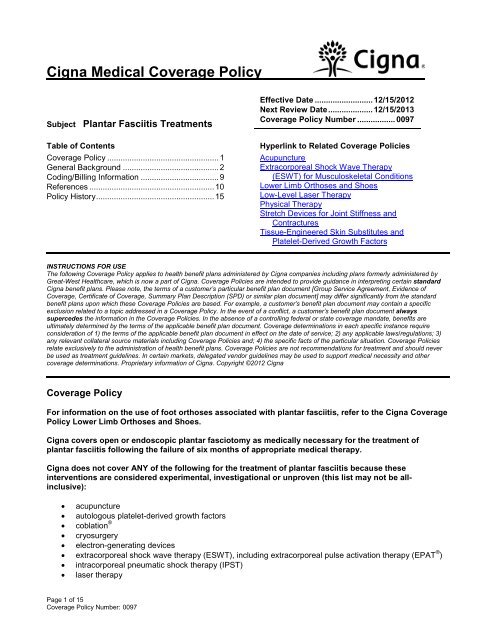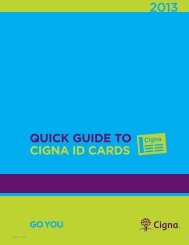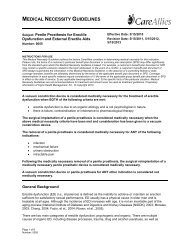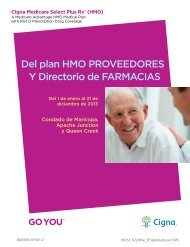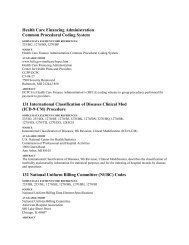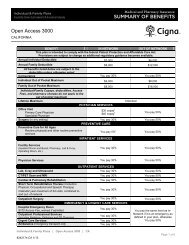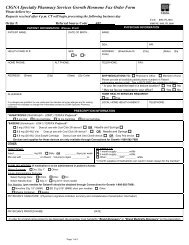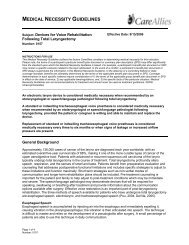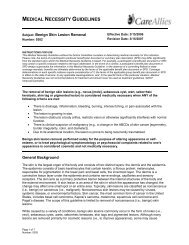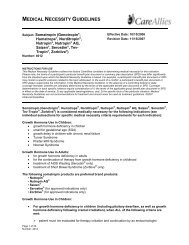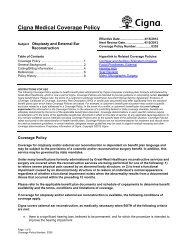Cigna medical coverage policy
Cigna medical coverage policy
Cigna medical coverage policy
You also want an ePaper? Increase the reach of your titles
YUMPU automatically turns print PDFs into web optimized ePapers that Google loves.
<strong>Cigna</strong> Medical Coverage Policy<br />
Subject Plantar Fasciitis Treatments<br />
Table of Contents<br />
Coverage Policy .................................................. 1<br />
General Background ........................................... 2<br />
Coding/Billing Information ................................... 9<br />
References ........................................................ 10<br />
Policy History ..................................................... 15<br />
Page 1 of 15<br />
Coverage Policy Number: 0097<br />
Effective Date .......................... 12/15/2012<br />
Next Review Date .................... 12/15/2013<br />
Coverage Policy Number ................. 0097<br />
Hyperlink to Related Coverage Policies<br />
Acupuncture<br />
Extracorporeal Shock Wave Therapy<br />
(ESWT) for Musculoskeletal Conditions<br />
Lower Limb Orthoses and Shoes<br />
Low-Level Laser Therapy<br />
Physical Therapy<br />
Stretch Devices for Joint Stiffness and<br />
Contractures<br />
Tissue-Engineered Skin Substitutes and<br />
Platelet-Derived Growth Factors<br />
INSTRUCTIONS FOR USE<br />
The following Coverage Policy applies to health benefit plans administered by <strong>Cigna</strong> companies including plans formerly administered by<br />
Great-West Healthcare, which is now a part of <strong>Cigna</strong>. Coverage Policies are intended to provide guidance in interpreting certain standard<br />
<strong>Cigna</strong> benefit plans. Please note, the terms of a customer’s particular benefit plan document [Group Service Agreement, Evidence of<br />
Coverage, Certificate of Coverage, Summary Plan Description (SPD) or similar plan document] may differ significantly from the standard<br />
benefit plans upon which these Coverage Policies are based. For example, a customer’s benefit plan document may contain a specific<br />
exclusion related to a topic addressed in a Coverage Policy. In the event of a conflict, a customer’s benefit plan document always<br />
supercedes the information in the Coverage Policies. In the absence of a controlling federal or state <strong>coverage</strong> mandate, benefits are<br />
ultimately determined by the terms of the applicable benefit plan document. Coverage determinations in each specific instance require<br />
consideration of 1) the terms of the applicable benefit plan document in effect on the date of service; 2) any applicable laws/regulations; 3)<br />
any relevant collateral source materials including Coverage Policies and; 4) the specific facts of the particular situation. Coverage Policies<br />
relate exclusively to the administration of health benefit plans. Coverage Policies are not recommendations for treatment and should never<br />
be used as treatment guidelines. In certain markets, delegated vendor guidelines may be used to support <strong>medical</strong> necessity and other<br />
<strong>coverage</strong> determinations. Proprietary information of <strong>Cigna</strong>. Copyright ©2012 <strong>Cigna</strong><br />
Coverage Policy<br />
For information on the use of foot orthoses associated with plantar fasciitis, refer to the <strong>Cigna</strong> Coverage<br />
Policy Lower Limb Orthoses and Shoes.<br />
<strong>Cigna</strong> covers open or endoscopic plantar fasciotomy as <strong>medical</strong>ly necessary for the treatment of<br />
plantar fasciitis following the failure of six months of appropriate <strong>medical</strong> therapy.<br />
<strong>Cigna</strong> does not cover ANY of the following for the treatment of plantar fasciitis because these<br />
interventions are considered experimental, investigational or unproven (this list may not be allinclusive):<br />
• acupuncture<br />
• autologous platelet-derived growth factors<br />
• coblation ®<br />
• cryosurgery<br />
• electron-generating devices<br />
• extracorporeal shock wave therapy (ESWT), including extracorporeal pulse activation therapy (EPAT ® )<br />
• intracorporeal pneumatic shock therapy (IPST)<br />
• laser therapy
• low-load prolonged-duration stretch (LLPS) devices/dynamic splinting (e.g., Dynasplint System ®<br />
,<br />
Ultraflex, Pro-glide <br />
Page 2 of 15<br />
Coverage Policy Number: 0097<br />
Dynamic ROM, Advance Dynamic ROM ®<br />
)<br />
• microwave diathermy<br />
• radiotherapy<br />
• stereotactic radiofrequency thermal lesioning<br />
• trigger-point needling and infiltration of the proximal medial gastrocnemius muscle<br />
General Background<br />
Plantar fasciitis is an overuse injury resulting in inflammation of the plantar fascia, which connects the heel to<br />
the toes. It is a common cause of heel pain in adults. Symptoms usually start gradually with mild pain at the<br />
heel, pain after exercise and pain with standing first thing in the morning. On physical examination, firm pressure<br />
will elicit a tender spot over the medial tubercule of the calcaneus. Risk factors for plantar fasciitis may include:<br />
obesity, age, being female, limited dorsiflexion of the ankle joint, prolonged weight bearing, and an increase in<br />
the amount of walking or running. Heel spurs are not necessarily associated with plantar fasciitis; heel spurs<br />
may be found in asymptomatic patients. Early treatment generally results in a shorter duration of symptoms.<br />
First-Line Treatment<br />
The mainstay of nonsurgical treatment and the standard of care for initial treatment is a program of stretching<br />
exercises, ice, activity modification, weight loss in overweight patients, recommendations for appropriate<br />
footwear, arch taping, nonsteroidal anti-inflammatory medications and shock-absorbing shoe inserts or<br />
orthoses. Prefabricated orthoses have been shown to be adequate for the majority of patients with various heel<br />
pain syndromes.<br />
Iontophoresis is also an accepted noninvasive therapy for plantar fasciitis. Iontophoresis is the use of electric<br />
impulses from a low-voltage galvanic current stimulation unit to drive topical corticosteroids into soft tissue<br />
structures. The effectiveness of iontophoresis combined with traditional modalities has been demonstrated in<br />
randomized controlled trials (RCTs) (Osborne and Allison, 2006; Gudeman, et al., 1997). Iontophoresis may be<br />
tried as part of a first-line physical therapy program.<br />
Second-Line Treatment<br />
In the event early treatment fails, night splints, steroidal anti-inflammatory injections or a walking cast are the<br />
next level of the standard of care.<br />
A night dorsiflexion splint allows passive stretching of the calf and the plantar fascia during sleep. In theory, it<br />
also allows healing to occur while the plantar fascia is in an elongated position, thereby creating less tension<br />
with the first step in the morning. A night splint can be molded from plaster or fiberglass casting material or may<br />
be a prefabricated plastic brace (Young, et al., 2001). A number of studies support the efficacy of night splints<br />
(Roos, et al., 2006; Crawford and Thomson, 2003; Barry, et al., 2002; Berlet, et al., 2002; Powell, 1998).<br />
Evidence on the effectiveness of steroid injections in reducing pain in patients with plantar fasciitis includes a<br />
systematic review of randomized and quasi-randomized controlled trials (Crawford and Thomson, 2003). In<br />
general, the studies that compared steroid injections with placebo substances showed initial significant<br />
improvement; however, studies that included follow-up after one month showed no difference in outcome at that<br />
time. This suggests that the effectiveness of steroid injections is short-term. Risks of steroid injection into the<br />
heel include rupture of the plantar fascia and fat pad atrophy.<br />
The use of a short-leg walking cast for several weeks is a standard of care as a final conservative step in the<br />
treatment of plantar fasciitis.<br />
Surgical Intervention<br />
Surgical intervention should be considered only for intractable pain which has not responded to 6–12 months of<br />
proper conservative treatment. Plantar fasciotomy can be conducted using open or endoscopic techniques.<br />
Endoscopic plantar fasciotomy is a less invasive technique requiring an incision of less than one-half inch in<br />
length and utilizing an arthroscope to visualize and release the fascia. It has been proposed as an improvement<br />
over open plantar fasciotomy, resulting in less trauma and improved recovery times. There are a substantial
number of retrospective studies supporting the use of endoscopic plantar fasciotomy. Based on the large<br />
number of reports of relief of heel pain from a series of nonrandomized trials, endoscopic plantar fasciotomy<br />
appears effective in the treatment of plantar fasciitis (Urovitz, et al., 2008, Boyle and Slater, 2003; O’Malley, et<br />
al., 2000; Lundeen, et al., 2000; Benton-Weil, et al., 1998).<br />
Unproven Therapies for Plantar Fasciitis<br />
There are many therapies that have been suggested for treatment of plantar fasciitis that are not proven in the<br />
literature and not accepted as standard of care.<br />
Acupuncture: Acupuncture is a method of producing analgesia or treating disease by stimulating anatomical<br />
locations on the skin by the penetration of needles. There are no studies specific to its efficacy in the treatment<br />
of plantar fasciitis. The overall body of evidence in general is of poor quality, consisting of numerous<br />
uncontrolled studies, case series and case reports. There is no evidence that supports the efficacy of<br />
acupuncture for the treatment of plantar fasciitis.<br />
Autologous Platelet-Derived Growth Factors: Autologous platelet-derived growth factors (APDGF) also<br />
referred to as autologous platelet concentrate , platelet-rich plasma, platelet-rich concentrate, have been<br />
proposed for the treatment of multiple conditions to enhance healing. In addition to hard and soft tissue wound<br />
healing, purported benefits of this treatment include reduced inflammation, decreased blood loss, and reduced<br />
postoperative narcotic requirements. Several centrifuges are designed to concentrate platelet-enriched plasma<br />
from small amounts of autologous blood at the point of care. The platelet concentrate can then combined with<br />
other substances to form a gel for patient application. Outcomes have been documented using APDGF injection<br />
for a wide range of indications, including musculoskeletal conditions. APDGF injection has been evaluated as a<br />
treatment for plantar fasciitis in few randomized controlled trials (RCTs) showing no significant improvement<br />
when compared to a control group.<br />
A comparative study (n=60) by Akşahin et al. (2012) evaluated patients with chronic plantar fasciitis treated with<br />
corticosteroid injection versus platelet rich plasma injection. Satisfactory results were achieved with both<br />
treatment methods. There were no significant differences in pain scores at three weeks and six months following<br />
injections (p>0.05). Study limitations include small patient population, short-term follow-up, and lack of<br />
randomized design.<br />
de Vos et al. (2010) conducted a systematic review (n=11 studies) of the evidence on autologous growth factor<br />
injections of whole blood or platelet-rich plasma for chronic tendinopathy. Chronic tendinopathy in this study<br />
included wrist extensors, flexors, plantar fasciopathy and patellar tendinopathy. There were six observational,<br />
non-controlled studies and five controlled clinical trials, two of which were determined to have appropriate<br />
randomization. The mean number of subjects was 40, with a range 20–100. Patients with chronic plantar<br />
fasciopathy were treated in three studies (n=218 subjects). Outcome measures included measurements of pain<br />
and function. The review found strong evidence that the use of injections with autologous whole blood should<br />
not be recommended. No high-quality studies were found on platelet-rich plasma treatment (de Vos, et al.,<br />
2010).<br />
Lee and Ahmad (2007) conducted a prospective, randomized, controlled, observer-blinded study (n=64) to<br />
compare the efficacy of intralesional autologous blood with corticosteroid injection for plantar fasciitis. Data<br />
were complete for 61 patients, 30 patients in the autologous blood group and 31 patients in the corticosteroid<br />
group. Over the six-month follow-up period, a significant reduction in pain levels was noted in both groups<br />
(p
corticosteroid injection groups, respectively. Larger, well-designed RCTs are needed to further define the role of<br />
autologous blood injection in the treatment for plantar fasciitis.<br />
There is insufficient evidence in the published peer-reviewed <strong>medical</strong> literature to support the use of autologous<br />
blood injection for the treatment of plantar fasciitis.<br />
Coblation ® : Coblation, also referred to as cold or controlled ablation, has recently been proposed as a therapy<br />
for plantar fasciitis. Coblation bipolar technology uses radiofrequency energy to excite the electrolytes in a<br />
conductive medium, such as saline solution, creating precisely focused plasma. The plasma particles are then<br />
able to break molecular bonds within tissue, causing the tissue to dissolve at relatively low temperatures. It is<br />
theorized that this plasma radiofrequency-based microsurgery may promote an angiogenic healing response.<br />
Because the current does not pass directly through tissue, there is minimal thermal injury to any surrounding<br />
tissues.<br />
Coblation technology can be delivered via a number of different wands, hand pieces and other electrosurgical<br />
systems. The ArthroCare Topaz MicroDebrider (ArthroCare Corporation, Sunnyvale, CA) was granted<br />
marketing approval by the FDA via the 510(k) process on March 5, 2006, because it is considered to be<br />
substantially equivalent to another device already on the market. The 510(k) summary stated that the orthopedic<br />
system is substantially equivalent to the ArthroCare Topaz ArthroWands. Under the FDA 510(k) approval<br />
process, the manufacturer is not required to supply to the FDA evidence of the effectiveness of the Topaz<br />
Microdebrider prior to marketing the device. According to the FDA, the Topaz MicroDebrider is indicated for<br />
debridement, resection, ablation, and coagulation of soft tissues and hemostasis of blood vessels in orthopedic<br />
and arthroscopic procedures.<br />
A prospective, double-blind RCT (n=80) to evaluate the effectiveness of Coblation-based fasciotomy using the<br />
Topaz MicroDebrider is currently underway. The primary outcome measure for this study will be pain relief.<br />
Secondary outcomes will include a comparison of postoperative complications and an assessment of function<br />
and quality of life by the SF-36 questionnaire. There were no studies identified in the published peer-reviewed<br />
literature that assess the effectiveness of Coblation-based fasciotomy for relieving pain associated with plantar<br />
fasciitis. Therefore, Coblation technology for this indication is unproven at present.<br />
Cryosurgery: Cryosurgery is a minimally invasive procedure that involves the use of extreme cold to destroy<br />
abnormal tissue. There is a paucity of studies investigating the efficacy of cryosurgery for the treatment of<br />
recalcitrant plantar fasciitis in the peer-reviewed <strong>medical</strong> literature. A retrospective case series (n=137) by<br />
Cavazos et al. (2009) reported success and failure rates of 77.4% and 22.6%, respectively for chronic plantar<br />
fasciitis patients treated with cryosurgery. A mean pain score decreased from 7.6 before cryosurgery to 1.1 (p <<br />
0.0005).at 24 months of follow-up. This study is limited by its retrospective, uncontrolled design.<br />
Allen and colleagues (2007) utilized cryosurgery for 59 consecutive patients (61 heels) who had failed prior<br />
conservative therapy and were considered surgical candidates. Study results suggested that pain decreased<br />
significantly after the procedure (p
Pain Relief System (Orthometrix, Inc., White Plains, NY); and the EMS Swiss Dolorclast® (Electro Medical<br />
Systems [EMS], North Attleboro, MA).<br />
Literature Review: The safety and effectiveness of ESWT for the treatment of plantar fasciitis have been<br />
evaluated in technology assessments, meta-analyses, and randomized controlled trials (RCTs). A number of<br />
RCTs (n=45─272) have compared ESWT to placebo for the treatment of plantar fasciitis with conflicting results.<br />
A greater reduction in heel pain for patients treated with ESWT has been reported in some studies (Ibrahim, et<br />
al., 2010; Gerdesmeyer, et al., 2008; Kudo, et al., 2006; Malay, et al., 2006; Theodore, et al., 2004; Rompe, et<br />
al., 2003), while similar improvement rates for both treatment and placebo groups have been reported in other<br />
studies (Haake, et al., 2003; Buchbinder, et al., 2002).<br />
Comparative studies have also not consistently demonstrated a greater reduction in heel pain for ESWT versus<br />
standard treatment options. A prospective series (n=37) by Othman and Ragab (2010) compared results of<br />
patients with chronic plantar fasciitis who were treated with endoscopic plantar fasciotomy to those treated with<br />
ESWT. The mean follow-up was 11 months for the fasciotomy group (n=17) and 7.6 months for the ESWT<br />
group (n=20). Endoscopic plantar fasciotomy was reported to give better results than ESWT, but with minor<br />
complications. It was noted that additional studies with larger populations and longer term follow-up is needed to<br />
determine the curative effects of ESWT (Othman and Ragab, 2010).<br />
An RCT (n=102) by Rompe et al. (2010) reported significantly greater changes in the Foot Function Index sum<br />
score for patients managed with plantar fascia-specific stretching (n=54) than for those managed with shockwave<br />
therapy (n=48) (p
was very small. A sensitivity analysis including only the four trials of highest quality did not produce evidence of<br />
a statistically significant benefit. The authors stated that this systematic review does not support the use of<br />
ESWT for the treatment of plantar heel pain in clinical practice (Thomson, et al., 2005).<br />
A Cochrane review by Crawford and Thomson (2003) found some indirect evidence that patients’ heel pain<br />
improves spontaneously. Patients with heel pain in all trial arms improved spontaneously, regardless of their<br />
treatment allocation, demonstrating that the condition is self-limiting in some patients. ESWT was evaluated in<br />
five RCTs using different doses, with no consensus reached regarding variation of range of energy (i.e., high<br />
versus low), number of pulses, or number of treatment sessions. The results of the meta-analysis found the<br />
effectiveness of ESWT for plantar fasciitis unclear.<br />
Ogden et al. (2002) conducted a meta-analysis of eight prospective RCTs evaluating the effectiveness of ESWT<br />
for plantar fasciitis (n=840). Treatment success was variably defined as complete or substantial relief of preprocedure<br />
symptoms, activity limitations, or both. Success rates for five studies using low-energy shock waves<br />
ranged from 58–88% (Rompe, et al., 1996; Rompe, et al., 1997; Krischek, et al., 1998; Dahmen, et al., 1995;<br />
Buch, et al., 2000). For the three studies that utilized high-energy shock waves, the success rates ranged from<br />
81–87% (Ogden, et al., 2001; Chen, et al., 2001; Wang, et al., 2000).<br />
Extracorporeal Pulse Activation Therapy (EPAT ® )<br />
More recently a variation of ESWT, referred to as EPAT and also known as extracorporeal acoustic wave<br />
therapy), has been proposed for orthopedic conditions and soft tissue inflammation. EPAT is described as lowenergy<br />
pulse-activated shockwave that may propose tissue healing.<br />
U.S. Food and Drug Administration (FDA): The D-ACTOR Vibration Massager System (Storz Medical AG,<br />
Tagerwilen, Switzerland) was granted marketing approval by the FDA via the 510(k) process on June 27, 2008.<br />
The D-Actor 200 is described as “a vibrating percussion massage system that operates by compressed air to<br />
perform pulse activation therapy on target muscles and tissues.” The device is intended to be used for the<br />
temporary increase in local blood circulation to relieve minor muscle aches and pains (FDA, 2008).<br />
Literature Review: Very limited data exists in the published peer-reviewed literature that is specific to the<br />
safety and effectiveness of EPAT. A case series (n=60) by Saxena et al. (2011) examined the use of EPAT for<br />
achilles tendinopathy and reported an overall pain improvement rate of 78% at one year follow-up.<br />
There is insufficient evidence to support the use of EPAT for the treatment of any orthopedic condition.<br />
Evidence in the form of randomized controlled studies with long-term follow-up is needed to determine safety<br />
and efficacy of this type of shockwave therapy.<br />
Insoles with Magnetic Foil: The theory behind magnet therapy is that magnetic fields create an electrical<br />
current that interrupts the transmission of pain signals in the central nervous system as well as increasing blood<br />
flow to an area, boosting the flow of oxygen and other nutrients, ultimately reducing pain and swelling. Two<br />
RCTs comparing magnetic versus sham insoles for reducing pain have demonstrated that there is no difference<br />
between the therapies in patients with plantar fasciitis (Winemiller, et al., 2003; Caselli, et al., 1997). The limited<br />
evidence found in the published peer-reviewed literature does not support the use of magnetic insoles for the<br />
treatment of plantar fasciitis.<br />
.<br />
Intracorporeal Pneumatic Shock Therapy: Intracorporeal pneumatic shock therapy (IPST) using a pneumatic<br />
lithotripter has also been proposed for the treatment of chronic plantar fasciitis. Lithotripsy with this device is<br />
commonly used to treat kidney and bladder stones.<br />
Very few studies exist in the published peer-reviewed <strong>medical</strong> literature evaluating the safety and effectiveness<br />
of IPST for the indication of plantar fasciitis. Dogramaci et al. (2010) conducted an RCT (n=50) in which patients<br />
were assigned to treatment with IPST (n=25) or to a placebo group (n=25). At six months of follow-up the rate of<br />
successful outcomes (i.e., pain, function) in the treatment group were significantly higher compared to the<br />
control group ((p
Laser Therapy: Laser therapy, also called low-level laser therapy (LLLT) is a form of phototherapy which<br />
involves the application of low-power monochromatic and coherent light to injuries and lesions to stimulate<br />
healing. LLLT is used to increase the speed, quality and tensile strength of tissue repair, resolve inflammation,<br />
and give pain relief.<br />
In a randomized, double-blind, placebo-controlled trial (n=25), Kiritsi et al. (2009) compared the effect of lowlevel<br />
laser therapy (LLLT) (n=15) versus placebo (n=10) on plantar fasciitis. Outcomes were documented by<br />
ultrasound of the plantar fascia and reported pain scores. Enrolled patients had unilateral plantar fasciitis, so the<br />
contralateral asymptomatic fascia was used as control. Pain levels were reported to be significantly improved<br />
after LLLT compared to the placebo group (i.e., after night rest [p=0.006], with daily activities [p=0.01]). The<br />
small sample size of this study limits the generalizability of results.<br />
Basford et al. (1998) conducted a randomized, double-blinded, placebo-controlled clinical study of 32 subjects<br />
comparing dummy versus active laser therapy over four weeks using relief of pain as the endpoint. No<br />
significant differences were found between the groups in pain scores either during treatment or at one-month<br />
follow-up.<br />
The available data regarding the efficacy of laser therapy for the treatment of plantar fasciitis is limited.<br />
Low-Load Prolonged-Duration Stretch (LLPS) Devices/Dynamic Splinting: Dynamic splinting uses lowload,<br />
prolonged duration stretch (LLPS) with calibrated, adjustable tension to increase time at end range of<br />
motion and thereby reducing contracture. Stretching with dynamic splinting has been proposed as a treatment<br />
for plantar fasciitis because the tension can adapt to changes in the plantar fascia. Available LLPS/dynamic<br />
splinting devices include:<br />
• Dynasplint System® (Dynasplint Systems, Inc., Severna Park, MD)<br />
• Ultraflex (Ultraflex Systems, Pottstown, PA)<br />
• Pro-glide Dynamic ROM devices (DeRoyal®, Powell, TN)<br />
• Advance Dynamic ROM® devices (Empi, St. Paul, MN)<br />
Studies in the published peer-reviewed <strong>medical</strong> literature evaluating the safety and effectiveness of include an<br />
RCT (n=60) by Sheridan et al. (2010). All patients received nonsteroidal anti-inflammatory drugs, orthoses, and<br />
corticosteroid injections as needed. The experimental group (n=30) also received dynamic splinting worn at<br />
night to obtain a LLPS with dynamic tension. A significant difference was found in the mean change from<br />
baseline in Plantar Fasciopathy Pain/Disability Scale scores of experimental over control patients (p
standard arm compared with the low-dose arm (p
gastroc-soleus complex. The guideline states that ESWT may be considered as an alternative to traditional<br />
surgical approaches for recalcitrant plantar heel pain (Thomas, et al., 2010).<br />
In a joint <strong>policy</strong> statement, the American Podiatric Medical Association (APMA) and the American College of<br />
Foot and Ankle Surgeons (ACFAS) acknowledge that ESWT is one of the many procedures used to treat<br />
plantar fasciitis. Despite the limited evidence from relatively small studies, few randomized trials, and conflicting<br />
results identified in the literature, the APMA/ACFAS concluded that “ESWT appears to be an efficacious, FDAapproved,<br />
non-surgical option in the treatment of chronic proximal plantar fasciitis” (APMA/ ACFAS, 2003).<br />
Summary<br />
Conservative first- and second-line treatments for plantar fasciitis are most often successful. For those who fail<br />
<strong>medical</strong> management, plantar fasciotomy or plantar fascia release may be considered. A number of unproven<br />
treatment modalities have been proposed for plantar fasciitis, the most controversial of which is extracorporeal<br />
shock wave therapy (ESWT). The evidence in the published peer-reviewed literature regarding the efficacy of<br />
ESWT, as well as the following proposed treatment options, remains inconclusive at this time:<br />
• acupuncture<br />
• autologous platelet injection platelet-derived growth factors<br />
• coblation ®<br />
• cryosurgery<br />
• electron-generating devices<br />
• extracorporeal shock wave therapy (ESWT) including extracorporeal pulse activation therapy (EPAT ® )<br />
• intracorporeal pneumatic shock therapy (IPST)<br />
• laser therapy<br />
• low-load prolonged-duration stretch (LLPS) devices/dynamic splinting<br />
• microwave diathermy<br />
• radiotherapy<br />
• stereotactic radiofrequency thermal lesioning<br />
• trigger-point needling and infiltration of the proximal medial gastrocnemius muscle<br />
Coding/Billing Information<br />
Note: This list of codes may not be all-inclusive.<br />
Covered when <strong>medical</strong>ly necessary:<br />
CPT ® *<br />
Codes<br />
Description<br />
28008 Fasciotomy, foot and/or toe<br />
29893 Endoscopic plantar fasciotomy<br />
ICD-9-CM Description<br />
Diagnosis<br />
Codes<br />
728.71 Plantar fascial fibromatosis<br />
Experimental/Investigational/Unproven/Not Covered when used for the treatment of plantar fasciitis:<br />
CPT* Codes Description<br />
20552 Injection(s); single or multiple trigger point(s), one or two muscle(s)<br />
20553 Injection(s); single or multiple trigger point(s), three or more muscle(s)<br />
28890 Extracorporeal shock wave, high energy, performed by a physician, requiring<br />
anesthesia other than local, including ultrasound guidance, involving the plantar<br />
fascia<br />
28899 † Unlisted procedure, foot or toes<br />
Page 9 of 15<br />
Coverage Policy Number: 0097
64632 Destruction by neurolytic agent; plantar common digital nerve<br />
77401 Radiation treatment delivery, superficial and/or ortho voltage<br />
97024 Application of a modality to one or more areas; diathermy (eg, microwave)<br />
97139 †<br />
Unlisted therapeutic procedure (specify)<br />
97799 † Unlisted physical medicine/rehabilitation service or procedure<br />
97810 Acupuncture, one or more needles; without electrical stimulation, initial 15<br />
minutes of personal one-on-one contact with the patient<br />
97811 Acupuncture, one or more needles; without electrical stimulation, initial 15<br />
minutes of personal one-on-one contact with the patient, with re-insertion of<br />
needle(s)<br />
97813 Acupuncture, one or more needles; with electrical stimulation, initial 15 minutes<br />
of personal one-on-one contact with the patient<br />
97814 Acupuncture, one or more needles; with electrical stimulation; initial 15 minutes<br />
of personal one-on-one contact with the patient, with re-insertion of needle(s)<br />
0019T Extracorporeal shock wave involving musculoskeletal system, not otherwise<br />
specified, low energy<br />
0101T Extracorporeal shock wave involving musculoskeletal system, not otherwise<br />
specified, high energy<br />
0232T Injection(s), platelet rich plasma, any site, including image guidance, harvesting<br />
and preparation when performed<br />
† NOTE: Experimental, investigational, unproven and not covered when used to report laser therapy or<br />
other non-covered modality outlined above for the treatment of plantar fasciitis.<br />
HCPCS Description<br />
Codes<br />
E1815 Dynamic adjustable ankle extension/flexion device, includes soft interface<br />
material<br />
E1816 Static progressive stretch ankle device, flexion and/or extension, with or without<br />
range of motion adjustment, includes all components and accessories<br />
P9020 Platelet rich plasma, each unit<br />
S8948 Application of a modality (requiring constant provider attendance) to one or more<br />
areas; low-level laser; each 15 minutes<br />
ICD-9-CM Description<br />
Diagnosis<br />
Codes<br />
728.71 Plantar fascial fibromatosis<br />
*Current Procedural Terminology (CPT ® ) © 2011 American Medical Association: Chicago, IL.<br />
References<br />
1. Allen BH, Fallat LM, Schwartz SM. Cryosurgery: an innovative technique for the treatment of plantar<br />
fasciitis. J Foot Ankle Surg. 2007 Mar-Apr;46(2):75-9.<br />
2. American Podiatric Medical Association (APMA)/American College of Foot and Ankle Surgeons<br />
(ACFAS). APMA and ACFAS Joint Policy Statement on Extracorporeal Shock Wave Therapy.<br />
December, 2003. Accessed May 10, 2006. Available at URL address:<br />
http://www.acfas.org/NR/rdonlyres/17CA33BD-A58B-40CB-9674-<br />
1392E7890076/0/ESWT_APMA_ACFASPolicyFinal_12_8_2003.pdf<br />
Page 10 of 15<br />
Coverage Policy Number: 0097
3. Akşahin E, Doğruyol D, Yüksel HY, Hapa O, Doğan O, Celebi L, et al. The comparison of the effect of<br />
corticosteroids and platelet-rich plasma (PRP) for the treatment of plantar fasciitis. Arch Orthop Trauma<br />
Surg. 2012 Jun;132(6):781-5. Epub 2012 Mar 8.<br />
4. Barry LD, Barry AN, Chen Y. A retrospective study of standing gastrocnemius-soleus stretching versus<br />
night splinting in the treatment of plantar fasciitis. J Foot ankle Surg. 2002 Jul-Aug;41(4):221-227.<br />
5. Basford JR, Malanga GA, Krause DA, Harmse WS. A randomized controlled evaluation of low-intensity<br />
laser therapy: plantar fasciitis. Arch Phys Med Rehab. 1998 Mar;79(3):49-254.<br />
6. Berlet GC, Anderson RB, Davis H, Kiebzak GM. A prospective trial of night splinting in the treatment of<br />
recalcitrant plantar fasciitis: the Ankle Dorsiflexion Dynasplint. Orthopedics. 2002 Nov;25(11):1273-<br />
1275.<br />
7. Benton-Weil W, Borrelli AH, Weil LS Jr, Weil LS Sr. Percutaneous plantar fasciotomy: a minimally<br />
invasive procedure for recalcitrant plantar fasciitis. J Foot Ankle Surg. 1998 Jul-Aug;37(4):269-272.<br />
8. Boyle RA, Slater GL. Endoscopic plantar fascia release: a case series. Foot Ankle Int. 2003<br />
Feb;24(2):176-179.<br />
9. Buchbinder R. Plantar fasciitis. N Engl J Med. 2004 May 20;350(21):2159-2166.<br />
10. Buchbinder R, Ptaszik, Gordon J, Buchman J, Prabaharan V, Forbes A. Ultrasound-guided<br />
extracorporeal shock wave therapy for plantar fasciitis. JAMA. 2002;288(11):1364-1372.<br />
11. California Technology Assessment Forum (CTAF). Extracorporeal Shock-wave Therapy (ESWT) for<br />
Plantar Fasciitis not Responding to Conservative Therapy. June 20, 2007. Accessed Jun 5, 2009,<br />
Available at URL address: http://www.ctaf.org/content/assessment/detail/739<br />
12. Caselli MA, Clark N, Lazarus S, Velez Z, Venegas L. Evaluation of magnetic foil and PPT Insoles in the<br />
treatment of heel pain. J Am Podiatr Med Assoc. 1997 Jan;87(1):1-16.<br />
13. Cavazos GJ, Khan KH, D'Antoni AV, Harkless LB, Lopez D. Cryosurgery for the treatment of heel pain.<br />
Foot Ankle Int. 2009 Jun;30(6):500-5.<br />
14. Cotchett MP, Landorf KB, Munteanu SE. Effectiveness of dry needling and injections of myofascial<br />
trigger points associated with plantar heel pain: a systematic review. J Foot Ankle Res. 2010 Sep<br />
1;3:18.<br />
15. Crawford F, Thomson C. Interventions for treating plantar heel pain. Cochrane Database Syst Rev.<br />
2003;(3):CD000416.<br />
16. de Vos RJ, van Veldhoven PL, Moen MH, Weir A, Tol JL, Maffulli N. Autologous growth factor injections<br />
in chronic tendinopathy: a systematic review. Br Med Bull. 2010;95:63-77. Epub 2010 Mar 2.<br />
17. Dogramaci Y, Kalaci A, Emir A, Yanat AN, Gökçe A. Intracorporeal pneumatic shock application for the<br />
treatment of chronic plantar fasciitis: a randomized, double blind prospective clinical trial. Arch Orthop<br />
Trauma Surg. 2010 Apr;130(4):541-6. Epub 2009 Aug 11.<br />
18. ECRI Institute. Extracorporeal Shock Wave Therapy for the Treatment of Plantar Fasciitis. Plymouth<br />
Meeting (PA): ECRI Institute Health Technology Assessment Information Service; 2006 November. 109<br />
p. (Evidence Report; no. 140). Available at URL address: http://www.ecri.org.<br />
19. Fink B, Mizel M. What’s new in foot and ankle surgery. J Bone Joint Surg Am. 2001;83-A(5):791-796.<br />
20. Furia JP. High-energy extracorporeal shock wave therapy as a treatment for insertional Achilles<br />
tendinopathy. Am J Sports Med. 2006 May;34(5):733-40.<br />
Page 11 of 15<br />
Coverage Policy Number: 0097
21. Gerdesmeyer L, Frey C, Vester J, Maier M, Weil L Jr, Weil L Sr, et al. Radial extracorporeal shock wave<br />
therapy is safe and effective in the treatment of chronic recalcitrant plantar fasciitis: results of a<br />
confirmatory randomized placebo-controlled multicenter study. Am J Sports Med. 2008<br />
Nov;36(11):2100-9. Epub 2008 Oct 1.<br />
22. Gollwitzer H, Diehl P, von Korff A, Rahlfs VW, Gerdesmeyer L. Extracorporeal shock wave therapy for<br />
chronic painful heel syndrome: a prospective, double blind, randomized trial assessing the efficacy of a<br />
new electromagnetic shock wave device. J Foot Ankle Surg. 2007 Sep-Oct;46(5):348-57.<br />
23. Greve JM, Grecco MV, Santos-Silva PR. Comparison of radial shockwaves and conventional<br />
physiotherapy for treating plantar fasciitis. Clinics (Sao Paulo). 2009;64(2):97-103.<br />
24. Gudeman SD, Eisele SA, Heidt RS Jr, Colosimo AJ, Stroupe AL. Treatment of plantar fasciitis by<br />
Iontophoresis of 0.4% dexamethasone. A randomized, double-blind, placebo-controlled study. Am J<br />
Sports Med. 1997 May-June;25(3):312-316.<br />
25. Haake M, Buch M, Shoellner C. Extracorporeal shock wave therapy for plantar fasciitis: randomized<br />
controlled multicenter trial. BMJ. 2003;327(7406):75.<br />
26. Hawke F, Burns J, Radford JA, du Toit V. Custom-made foot orthoses for the treatment of foot pain.<br />
Cochrane Database Syst Rev. 2008 Jul 16;(3):CD006801<br />
27. Ho C. Extracorporeal shock wave treatment for chronic plantar fasciitis (heel pain). Issues Emerg Health<br />
Technol. 2007 Jan;(96 (part 1)):1-4.<br />
28. Huang HH, Oureshi AA, Biundo JJ Jr. Sports and other soft tissue injuries, tendonitis, bursitis, and<br />
occupation-related syndromes. Curr Opin Rheumatol. 2000;12:150-154.<br />
29. Ibrahim MI, Donatelli RA, Schmitz C, Hellman MA, Buxbaum F. Chronic plantar fasciitis treated with two<br />
sessions of radial extracorporeal shock wave therapy. Foot Ankle Int. 2010 May;31(5):391-7.<br />
30. Imamura M, Imamura S, De Carvalho AE Jr, Mazagao RA, Casisus DA, Fischer AA. Plantar fasciitis: A<br />
new treatment approach. Arch Phys Med. 2003 Sep;84(9):E4.<br />
31. Kiritsi O, Tsitas K, Malliaropoulos N, Mikroulis G. Ultrasonographic evaluation of plantar fasciitis after<br />
low-level laser therapy: results of a double-blind, randomized, placebo-controlled trial. Lasers Med Sci.<br />
2009 Oct 20. [Epub ahead of print]<br />
32. Kiter E, Celikbas E, Akkaya S, Demirkan F, Kilic BA. Comparison of injection modalities in the treatment<br />
of plantar heel pain: a randomized controlled trial. J Am Podiatr Med Assoc. 2006 Jul-Aug;96(4):293-6.<br />
33. Krischek O, Rompe JD, Herbsthofer B, Nafe B. Symptomatic low-energy shockwave therapy in heel<br />
pain and radiologically detected plantar heel spur. Orthop Ihre Grenzgeb. 1998 Mar-Apr;136(2):169-<br />
174.<br />
34. Landorf KB, Keenan AM, Herbert RD. Effectiveness of different types of foot orthoses for the treatment<br />
of plantar fasciitis. J Am Podiatr Med Assoc. 2004 Nov-Dec;94(6):542-9.<br />
35. Landorf KB, Keenan AM, Herbert RD. Effectiveness of foot orthoses to treat plantar fasciitis: a<br />
randomized trial. Arch Intern Med. 2006 Jun 26;166(12):1305-10.<br />
36. Lee TG, Ahmad TS. Intralesional autologous blood injection compared to corticosteroid injection for<br />
treatment of chronic plantar fasciitis. A prospective, randomized, controlled trial. Foot Ankle Int. 2007<br />
Sep;28(9):984-90.<br />
37. Lundeen RO, Aziz S, Burks JB, Rose JM. Endoscopic plantar fasciotomy; a retrospective analysis of<br />
results in 53 patients. J Foot Ankle Surg. 2000 Jul-Aug;39(4):208-217.<br />
Page 12 of 15<br />
Coverage Policy Number: 0097
38. McPoil TG, Martin RL, Cornwall MW, Wukich DK, Irrgang JJ, Godges JJ. Heel pain--plantar fasciitis:<br />
clinical practice guidelines linked to the international classification of function, disability, and health from<br />
the orthopaedic section of the American Physical Therapy Association. J Orthop Sports Phys Ther.<br />
2008 Apr;38(4):A1-A18. Epub 2008 Mar 31.<br />
39. Micke O, Seegenschmiedt MH. Radiotherapy in painful heel spurs (plantar fasciitis): results of a national<br />
patterns of care study. Int J Radiation Oncology Biol Phys. 2004;58(3):828-843.<br />
40. Miszczyk L, Jochymek B, Wozniak G. Retrospective evaluation of radiotherapy in plantar fasciitis. Br J<br />
Radiol. 2007 Oct;80(958):829-34. Epub 2007 Sep 17.<br />
41. National Institute for Clinical Excellence (NICE). Interventional procedure overview of extracorporeal<br />
shockwave therapy for refractory plantar fasciitis. April 2009a. Accessed November 6, 2009. Available<br />
at URL address: http://www.nice.org.uk/guidance/index.jsp?action=download&o=43959<br />
42. National Institute for Clinical Excellence (NICE). Extracorporeal shockwave therapy for refractory plantar<br />
fasciitis. Guidance. August 2009b. Accessed November 6, 2009. Available at URL address:<br />
http://www.nice.org.uk/nicemedia/pdf/IPG311Guidance.pdf<br />
43. Niewald M, Seegenschmiedt MH, Micke O, Graeber S, Muecke R, Schaefer V, et al. Randomized,<br />
multicenter trial on the effect of radiation therapy on plantar fasciitis (painful heel spur) comparing a<br />
standard dose with a very low dose: mature results after 12 months' follow-up. Int J Radiat Oncol Biol<br />
Phys. 2012 Nov 15;84(4):e455-62. doi: 10.1016/j.ijrobp.2012.06.022. Epub 2012 Jul 25.<br />
44. Ogden JA, Alvarez R, Levitt R, Cross GL, Marlow M. Shock wave therapy for chronic proximal plantar<br />
fasciitis. Clin Orthop Rel Res. 2001;387:47-59.<br />
45. O’Malley J|MJ, Page A, Cook R. Endoscopic plantar fasciotomy for chronic heel pain. Foot Ankle Int.<br />
2000 Jun;21(6):505-510.<br />
46. Osborne HR, Allison GT. Treatment of plantar fasciitis by LowDye taping and iontophoresis: short term<br />
results of a double blinded, randomised, placebo controlled clinical trial of dexamethasone and acetic<br />
acid. Br J Sports Med. 2006 Jun;40(6):545-9; discussion 549. Epub 2006 Feb 17.<br />
47. Othman AM, Ragab EM. Endoscopic plantar fasciotomy versus extracorporeal shock wave therapy for<br />
treatment of chronic plantar fasciitis. Arch Orthop Trauma Surg. 2010 Nov;130(11):1343-7. Epub 2009<br />
Dec 24.<br />
48. Pfeffer G, Bacchetti P, Deland J, Lewis A, Anderson R, Davis W. et al. Comparison of custom and<br />
prefabricated orthoses in the initial treatment of proximal plantar fasciitis. Foot Ankle Int. 1999<br />
Apr;20(4):214-221.<br />
49. Porter MD, Shadbolt B. Intralesional corticosteroid injection versus extracorporeal shock wave therapy<br />
for plantar fasciopathy. Clin J Sport Med. 2005 May;15(3):119-24.<br />
50. Powell M, Post WR, Keener J, Wearden S. Effective treatment of chronic plantar fasciitis with<br />
dorsiflexion night splints: a crossover prospective randomized outcome study. Foot Ankle Int. 1998<br />
Jan;19(1):10-18.<br />
51. Probe RA, Baca M, Adams R, Preece C. Night splint treatment for plantar fasciitis. Clinical Orthopaedics<br />
and Related Research. 1999;368:190-195.<br />
52. Rompe JD, Hopf C, Nafe B, Burger R. Low-energy extracorporeal shock wave therapy for painful heel: a<br />
prospective controlled single-blind study. Orthop Trauma Surg. 1996;115(2):75-79.<br />
53. Rompe JD, Schoellner, Carsten MD, Nafe B. Evaluation of Low-Energy Extracorporeal Shock Wave<br />
Application for Treatment of Chronic Plantar Fasciitis. J Bone Joint Surg Am. 2002 Mar;84-A (3):335-<br />
341.<br />
Page 13 of 15<br />
Coverage Policy Number: 0097
54. Rompe JD, Furia J, Weil L, Maffulli N. Shock wave therapy for chronic plantar fasciopathy. Br Med Bull.<br />
2007;81-82:183-208. Epub 2007 Apr 24.<br />
55. Rompe JD, Cacchio A, Weil L Jr, Furia JP, Haist J, Reiners V, et al. Plantar fascia-specific stretching<br />
versus radial shock-wave therapy as initial treatment of plantar fasciopathy. J Bone Joint Surg Am. 2010<br />
Nov;92(15):2514-22.<br />
56. Roos E, Engstrom M, Soderberg B. Foot orthoses for the treatment of plantar fasciitis. Foot Ankle Int.<br />
2006 Aug;27(8):606-11.<br />
57. Saxena A, Ramdath S Jr, O'Halloran P, Gerdesmeyer L, Gollwitzer H. Extra-corporeal pulsed-activated<br />
therapy ("EPAT" sound wave) for Achilles tendinopathy: a prospective study. J Foot Ankle Surg. 2011<br />
May-Jun;50(3):315-9. Epub 2011 Mar 15.<br />
58. Seil R, Wilmes P, Nuhrenborger C. Extracorporeal shock wave therapy for tendinopathies. Expert Rev<br />
Med Devices. 2006 Jul;3(4):463-70.<br />
59. Sheridan L, Lopez A, Perez A, John MM, Willis FB, Shanmugam R. Plantar fasciopathy treated with<br />
dynamic splinting: a randomized controlled trial. J Am Podiatr Med Assoc. 2010 May-Jun;100(3):161-5.<br />
60. Sollitto RJ, Plotkin EL, Klein PG, Mullin P. Early clinical results of the use of radiofrequency lesioning in<br />
the treatment of plantar fasciitis. J Foot Ankle Surg. 1997 May-Jun;36(3):215-219.<br />
61. Stuber K, Kristmanson K. Conservative therapy for plantar fasciitis: a narrative review of randomized<br />
controlled trials. JCCA J Can Chiropr Assoc. 2006 Jun;50(2):118-33.<br />
62. Theodore GH, Buch M, Amendola A, Bachmann C, Fleming LL, Zingas C. Extracorporeal shock wave<br />
therapy for the treatment of plantar fasciitis. Foot Ankle Int. 2004 May;25(5):290-7.<br />
63. Thomas JL, Christensen JC, Kravitz SR, Mendicino RW, Schuberth JM, Vanore JV, Weil LS Sr, Zlotoff<br />
HJ, Bouché R, Baker J; American College of Foot and Ankle Surgeons heel pain committee. The<br />
diagnosis and treatment of heel pain: a clinical practice guideline-revision 2010. J Foot Ankle Surg.<br />
2010 May-Jun;49(3 Suppl):S1-19.<br />
64. Tice JA. Extracorporeal Shock Wave Therapy for Musculoskeletal Disorders. California Technology<br />
Assessment Forum (CTAF). June 9, 2004. Accessed May 10, 2006. Available at URL address:<br />
http://www.ctaf.org/content/assessments_pdf/32362336391_ESWT%2004%20final.pdf<br />
65. Urovitz EP, Birk-Urovitz A, Birk-Urovitz E. Endoscopic plantar fasciotomy in the treatment of chronic<br />
heel pain. Can J Surg. 2008 Aug;51(4):281-3.<br />
66. U.S. Food and Drug Administration (FDA). Ossatron® Premarket Approval (PMA). Accessed May 20,<br />
2005. Available at URL address: http://www.fda.gov/cdrh/pdf/p990086b.pdf<br />
67. U.S. Food and Drug Administration (FDA). ArthroCare Topaz ArthroWands. 510(k) Summary.<br />
Accessed May 12, 2007. Available at URL address: http://www.fda.gov/cdrh/pdf5/K053567.pdf<br />
68. U.S. Food and Drug Administration (FDA). 510(k) Summary. D-ACTOR Vibration Massager System.<br />
June 2008. Accessed Nov 11, 2011. Available at URL address:<br />
http://www.accessdata.fda.gov/cdrh_docs/pdf7/K072809.pdf<br />
69. Wilner JM, Strash WW. Extracorporeal shockwave therapy for plantar fasciitis and other<br />
musculoskeletal conditions utilizing the Ossatron--an update. Clin Podiatr Med Surg. 2004<br />
Jul;21(3):441-7, viii.<br />
70. Winemiller MH, Billow RG, Laskowski ER, Harmsen WS. Effect of magnetic vs sham-magnetic insoles<br />
on plantar heel pain. JAMA. 2003 Sep 17;290(11):1474-1479.<br />
Page 14 of 15<br />
Coverage Policy Number: 0097
71. Young C, Rutherford D, Niedfeldt M. Treatment of plantar fasciitis. Am Fam Physician. 2001;63(3):467-<br />
474.<br />
Policy History<br />
Pre-Merger Last Review Policy Title<br />
Organizations Date Number<br />
<strong>Cigna</strong> HealthCare 6/15/2008 0097 Plantar Fasciitis Treatments<br />
The registered marks "<strong>Cigna</strong>" and "<strong>Cigna</strong> HealthCare" as well as the "Tree of Life" logo are owned by <strong>Cigna</strong> Intellectual Property, Inc., licensed<br />
for use by <strong>Cigna</strong> Corporation and its operating subsidiaries. All products and services are provided by or through such operating subsidiaries<br />
and not by <strong>Cigna</strong> Corporation. Such operating subsidiaries include Connecticut General Life Insurance Company, <strong>Cigna</strong> Health and Life<br />
Insurance Company, <strong>Cigna</strong> Behavioral Health, Inc., <strong>Cigna</strong> Health Management, Inc., and HMO or service company subsidiaries of <strong>Cigna</strong> Health<br />
Corporation and <strong>Cigna</strong> Dental Health, Inc. In Arizona, HMO plans are offered by <strong>Cigna</strong> HealthCare of Arizona, Inc. In California, HMO plans are<br />
offered by <strong>Cigna</strong> HealthCare of California, Inc. In Connecticut, HMO plans are offered by <strong>Cigna</strong> HealthCare of Connecticut, Inc. In North<br />
Carolina, HMO plans are offered by <strong>Cigna</strong> HealthCare of North Carolina, Inc. In Virginia, HMO plans are offered by <strong>Cigna</strong> HealthCare Mid-<br />
Atlantic, Inc. All other <strong>medical</strong> plans in these states are insured or administered by Connecticut General Life Insurance Company or <strong>Cigna</strong> Health<br />
and Life Insurance Company.<br />
Page 15 of 15<br />
Coverage Policy Number: 0097


